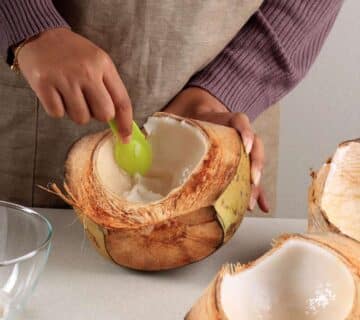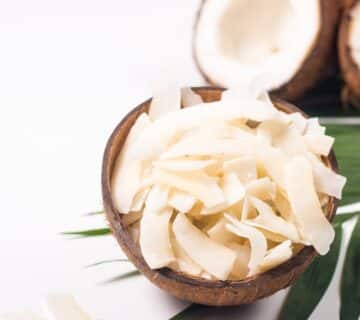Desiccated coconut is a versatile ingredient used in baking, cooking, and confectionery around the world. Its long shelf life and ability to maintain the natural flavor and texture of fresh coconut make it a staple in many kitchens.
However, because desiccated coconut is dried, there are times when rehydrating it can enhance its texture, making it softer and more suitable for certain recipes, like coconut cakes, puddings, or curries. We will share how to rehydrate desiccated coconut effectively, using either water or milk, and when each method is ideal.
Why Rehydrate Desiccated Coconut?
Rehydrating desiccated coconut serves several purposes. While desiccated coconut works well as a crunchy topping or ingredient for dry baked goods, some recipes require a softer, more hydrated texture.
Rehydrating allows the coconut to regain some of its moisture, closely mimicking the texture of fresh coconut. Here’s another reason you might want to rehydrate desiccated coconut:
A. Texture Restoration
Some recipes, like coconut milk-based curries or coconut-flavored desserts, require the moisture of fresh coconut. Rehydrating the desiccated version ensures a soft, fresh texture.
B. Increased Versatility
Hydrated coconut is more versatile for both savory and sweet dishes. It can be blended, mashed, or mixed into liquids more easily.
C. Enhanced Flavor
The process of adding moisture back into the coconut releases more of its natural oils, intensifying the coconut flavor.
D. Preservation of Nutrients
Desiccated coconut retains most of the nutrients of fresh coconut, and by rehydrating it, you help release those nutrients into your dishes.
How to Rehydrate Desiccated Coconut
There are two primary ways to rehydrate desiccated coconut: using water or using milk. The method you choose depends on the texture and richness you want in the final dish. Here’s the full explanations on how to rehydrate desiccated coconut:
1. Rehydrating Desiccated Coconut with Water
Rehydrating desiccated coconut with water is the most common method. It’s simple and quick, making the coconut soft and ready to use in a variety of dishes.
A. Step-by-Step Instructions
- Measure the Desiccated Coconut
Start by measuring the amount of desiccated coconut you need for your recipe. For most purposes, the ratio of coconut to water is about 1:1, though you may adjust based on the texture you desire.
- Boil Water
Bring a sufficient amount of water to a boil. You’ll want to use hot water rather than cold or room temperature water, as the heat helps speed up the absorption process.
- Pour Water Over the Coconut
Place the desiccated coconut in a bowl and pour the hot water over it. Stir the coconut to ensure the water is evenly distributed throughout.
- Let it Sit
Allow the coconut to sit and absorb the water for about 10-15 minutes. During this time, the coconut will plump up and soften.
- Drain Excess Water
If there is any excess water after the coconut has fully rehydrated, drain it off. Your coconut should now be soft and ready to use in any recipe that requires a more hydrated texture.
2. Rehydrating Desiccated Coconut with Milk
If you want to enhance the richness and flavor of the desiccated coconut, using milk instead of water is an excellent option. Milk not only rehydrates the coconut but also imparts a creamy texture and adds a subtle richness, making it perfect for desserts and rich dishes.
B. Step-by-Step Instructions:
- Measure the Coconut
As with water, measure the amount of desiccated coconut you need. A 1:1 ratio of coconut to milk works well, but you can adjust based on the desired consistency.
- Heat the Milk
Heat milk in a saucepan until it is hot but not boiling. Any type of milk can be used; whole milk, coconut milk, almond milk, or even cream for a richer result.
- Combine the Coconut and Milk
Place the desiccated coconut in a bowl and pour the hot milk over it. Stir the coconut to ensure it’s fully soaked in the milk.
- Let it Absorb
Let the coconut sit in the milk for 10-15 minutes. The coconut will absorb the milk and become softer and richer.
- Use Immediately or Store
After the coconut has absorbed the milk, you can use it right away in recipes like coconut rice pudding, coconut-flavored custards, or even savory coconut curries. If you’re not using it immediately, store it in an airtight container in the refrigerator.
Rehydrate Desiccated Coconut for More Flavour!
Milk is more effective than water when it comes to rehydrating desiccated coconut, as it enhances the coconut’s natural richness and flavor. Milk is typically used for making desiccated coconut desserts, creamy curries, or indulgent breakfasts.
On the other hand, water is commonly used for baking, smoothies, or as a topping for coconut-based treats. For the best rehydration results, using high-quality ingredients is key.
When it comes to premium desiccated coconut, Sari Coconut is a trusted supplier for food industries worldwide. Whether you’re baking, cooking, or producing large-scale food products, Sari Coconut delivers the finest quality to meet your needs.
As a supplier desiccated coconut, is processed with care to preserve its natural flavor, texture, and nutritional value. This versatile ingredient is used in countless food applications, from bakery items to confectionery and even savory dishes.
Businesses across the United States, European countries, India, China, Asia, Africa, and the United Arab Emirates rely on Sari Coconut for their coconut needs. With safe and reliable delivery and at competitive prices, you can easily enjoy the desiccated coconut benefits from Sari Coconut!
FAQ
Can I rehydrate sweetened desiccated coconut?
Yes, sweetened desiccated coconut can be rehydrated the same way as unsweetened coconut. However, keep in mind that the sugar content may cause the coconut to become stickier, and the overall texture may be slightly different.
How long can I store rehydrated coconut?
Rehydrated coconut should be used within 2-3 days. Store it in an airtight container in the refrigerator to maintain its freshness.
Can I freeze rehydrated coconut?
Yes, rehydrated coconut can be frozen for up to a month. Make sure to pack it in a freezer-safe, airtight container to prevent freezer burn.






